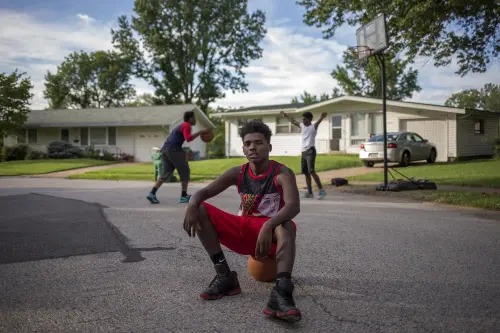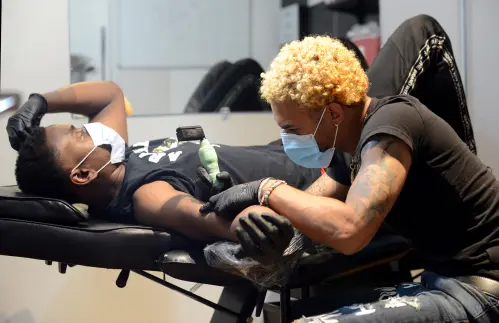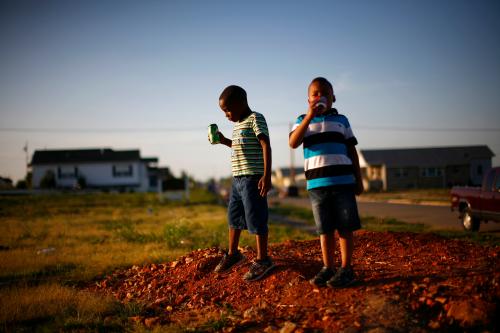This paper was prepared for the November 19, 2020 event on overcoming challenges faced by Black boys and men for the Brookings Institution, Future of the Middle Class Initiative.
“To be male, poor, and either African-American or Native-American is to confront, on a daily basis, a deeply held racism that exists in every social institution,” writes our Brookings colleague Camille Busette. “No other demographic group has fared as badly, so persistently and for so long.” To meet this “appalling crisis,” Camille calls for nothing less than “a New Deal for Black men.”
Creating this New Deal is one of the core priorities of the Race, Prosperity and Inclusion Initiative, directed by Camille, but also of the new Boys and Men Project launched today out of the Center on Children and Families. The elements of this New Deal will likely consist of intentional policymaking in the fields of education and training, the labor market, family policy (especially for fathers), criminal justice reform, and tackling concentrated poverty.
This is one area where it is reasonable to hope for some bipartisan action. Witness the creation in 2019 of a new Commission on the Social Status of Black Men and Boys, charged with recommending policies to “improve upon, or augment, current government programs.” This bipartisan Commission, consisting of 19 members, will “investigate potential civil rights violations affecting black males and study the disparities they experience in education, criminal justice, health, employment, fatherhood, mentorship and violence.” The Commission is required by law to report annually and “make recommendations to improve the social conditions and provide vital guidance for Congress on effective strategies to reduce the racial disparities in education, criminal justice, health and employment.”
The legislation to create the Commission was introduced in the House by Representative Frederica Wilson (D-FL) and sponsored in the Senate by Marco Rubio (R-FL), Kamala Harris (D-CA), and Cory Booker (D-NJ). This is a welcome and positive development. It will be important for the Commission to fully understand the challenges facing Black men specifically, in order to target policy appropriately. Black boys and Black men, in particular, run the gauntlet of a specific brand of racism, at the sharp intersection of race and gender.
Here, we provide some key facts on Black men’s outcomes in eight important domains, compared to Black women, white women, and white men.
1. Education
In 2019, 28% of Black men ages 25-29 had a bachelor’s degree or higher, compared to 30% of Black women, over 40% of white men, and nearly half of white women, according to the National Center of Education Statisticsin 2019. The gap is greater still at higher education levels: only half as many Black men have a Masters’degree (4%) as Black women (9%), white men (8%) and white women (13%):
2. Upward mobility
Black women and white women raised by low-income parents those in the bottom 20% of the income distribution) have similar rates of upward intergenerational mobility, measured in terms of their individual income as adults. Black men, by contrast, are much less likely than white men to rise up the income ladder, according to Raj Chetty and his team at Opportunity Insightswho have crunched the numbers on 20 million Americans in the 1978-1983 birth cohorts. A third of white men raised by low-income parents end up in the top 40% of the income distribution as adults, compared to only 19% of Black boys.
The figure below shows the probability of moving up the income ladder for children raised by low-income parents by race. The data shows that Black men raised by low-income parents face twice the risk of remaining stuck in intergenerational poverty (38%) as Black women (20%) in terms of their individual income. Note however that Black women fare worse in terms of household income than in individual income, especially compared to whites—itself a reflection, in part, of the worse outcomes for Black men.
3. Earnings
Black workers—regardless of gender—earn less than white workers, and white men have substantially out-earned white women and Black workers since 1980, according to Current Population Survey data. For both Black and white workers, men earn more; but the gender gap is much smaller for Black workers. The figure below shows the weekly earnings of full-time workers (hourly and non-hourly) for Black and white workers by gender since 1980. The results are striking: Black men earn $378 less per week than white men and $125 less than white women. Overall white women have seen the biggest increase in earnings, overtaking Black men in the 1990s.
4. Labor force participation
The labor force participation rate for Black men aged 20 and over is 5.6 percentage points lower than for white men, the U.S. Bureau of Labor Statistics estimates (note that this excludes the incarcerated population). Many men and women face different considerations when deciding to participate in the labor force – so here for simplicity we compare Black and white men in terms of labor force participation:
5. Unemployment during the COVID-19 pandemic
Black men have the highest unemployment rate of civilian non-institutionalized Black and white men and women over age 20, according to the Bureau of Labor Statistics. There was a large race gap in unemployment (independent of gender) even before COVID-19 swept the U.S.
Prior to March 2020, Black men consistently had among the highest unemployment rates of Black and white workers. Unemployment shot up for everyone in April, and Black women faced higher unemployment than Black men for two months. As unemployment began to fall for most in June, Black men’s unemployment rose and remained high through September (the last month data is available). In September, 12.6% of Black men were unemployed, compared to 6.5% of white men.
6. Life expectancy
Women live longer than men, on average—but there are big race gaps, too. Life expectancy is lowest for Black men (among Black and white people), according the CDC National Center for Health Statistics, both at birth and at age 65. For white men, life expectancy at birth is about 6 years lower than at age 65. But for Black men, that gap is over 9 years—showing that Black men are more likely to die prematurely.
7. COVID-19 death
Black men have been the most likely among Black and white Americans to die of COVID-19 at a rate 2.4 times that of white men, according to CDC data through July 2020. The figure below showed that 80 of 100,000 Black men in the U.S. had died of COVID-19 by July 4.
8. Criminal justice
Black men face a much higher chance of being incarcerated, according to Bureau of Justice data. The figure below shows the proportion of state and federal prisoners of each race and gender, compared to the shared of the U.S. adult population. Black men are overrepresented among prisoners by a factor of five (32% v. 6%).
The case for action
These are hard facts but ones that have to be faced in order to respond to the once-in-a-generation moment of racial reckoning taking place in the U.S. right now. Policymakers should consider Black men’s experience—and these select facts—through the lens of “intersectionality,” a framework pioneered by Kimberlé Crenshaw for examining how identities can combine to create specific nodes of disadvantage. Intersectionality points to the need to see individuals in the context of a wide range of identities, rather than in simple binary terms, such as male or female, Black or white or gay or straight. This can highlight the position of “multiply-burdened” groups, as Crenshaw puts it.
On many social and economic measures, Black men fare worse not only than white men, but white and Black women, as we show above. Part of the cause is that Black men are “uniquely stigmatized,” according to studies of implicit bias conducted by political scientists Ismail White and Corrine McConnaughy: more than 40% of white respondents rank “many or almost all” Black men as “violent.” White men are less than half as likely to be described in this way, at about the same rates as for Black women, while white women are very unlikely to be labeled as violent. It’s no surprise, then, that Black men are also more likely to be stopped by the police, more likely to be frisked, more likely to be arrested, more likely to be convicted, and more likely to be killed by law enforcement. As Rashawn Ray, a Rubenstein Fellow at Brookings argues, “Black men have a different social reality from their black female counterparts,” he writes. “The perceptions of others influence black men’s social interactions with co-workers and neighbors [and] structure a unique form of relative deprivation…In this regard, the intersectionality framework becomes useful for illuminating black men’s multiplicities and vulnerabilities.”
Given the weight of evidence on the specific, and unique plight of Black men, general policy recommendations will not suffice. Breaking the cycle of intergenerational disadvantage for Black boys and men requires first a deeper understanding the gendering of their race—and the racialization of their gender—and second, a battery of specifically tailored policy interventions: a New Deal for Black Men, no less.









Commentary
The challenges facing Black men – and the case for action
November 19, 2020